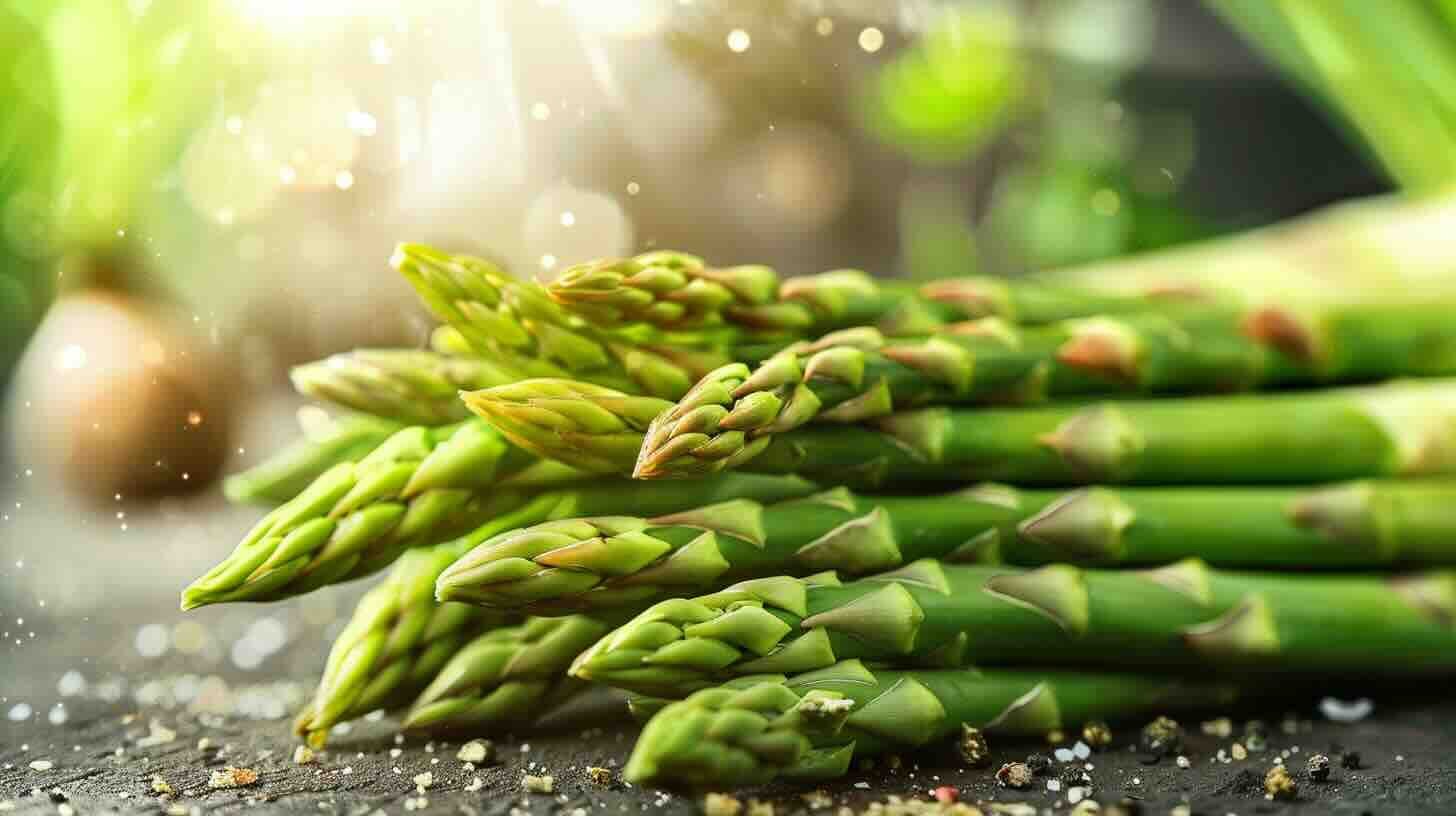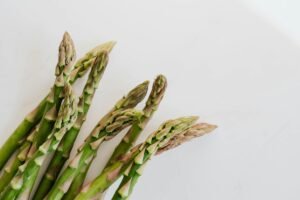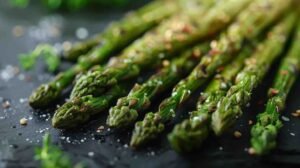Exploring Asparagus
Introduction to Asparagus
Asparagus, a vibrant green spear, stands tall in the world of vegetables, known for its unique flavor and impressive versatility in the kitchen. When I think of spring, asparagus comes to mind as the star of the season, bringing a fresh taste to the table. This perennial garden favorite has a history that stretches back to ancient times, revered for its culinary delights and medicinal properties. Asparagus can be enjoyed in various forms, from lightly steamed to fully incorporated in an elaborate dish. The quest to master how to cook asparagus can be as simple or sophisticated as you desire, making it a go-to for young home chefs and asparagus aficionados alike.
Health Benefits of Asparagus
Asparagus is not only a delight for the taste buds but also a powerhouse of nutrients. It’s low in calories yet rich in essential vitamins and minerals. Here’s a snapshot of the nutritional profile of asparagus:
| Nutrient | Amount per 100g |
|---|---|
| Calories | 20 |
| Protein | 2.2g |
| Dietary Fiber | 2.1g |
| Vitamin K | 41.6µg |
| Folate (Vitamin B9) | 52µg |
| Vitamin C | 5.6mg |
| Vitamin A | 756 IU |
The spears are abundant in antioxidants, which combat oxidative stress and may reduce the risk of chronic diseases. Asparagus is also known for its digestive benefits, thanks to its high fiber content which aids in digestive health and regularity. Additionally, the presence of folate makes it particularly beneficial for pregnant women or those planning pregnancy, as folate is vital for fetal development.
For those keeping an eye on their well-being, incorporating asparagus into your diet can contribute to improved nutritional intake. Whether you’re preparing a simple roasted asparagus recipe or experimenting with an asparagus soup recipe, this green gem is a fantastic way to enrich your meals with both flavor and nutrition. Discover more asparagus recipes to delight your palate and boost your health.
Buying and Preparing Asparagus
When I’m in the mood for a green, nutritious side dish, asparagus often comes to mind. It’s versatile and can be prepared in a variety of ways. Let’s dive into how to select the best asparagus and prepare it for cooking.
Selecting Fresh Asparagus
When I’m at the store or market, I always look for asparagus that appears fresh and vibrant. Here’s what I keep an eye out for:
- Stalks: The stalks should be firm and straight. They should not be limp or overly bendable.
- Tips: The tips are the best indicators of freshness. They should be tightly closed and compact, not mushy or beginning to spread open.
- Color: I look for a rich green color, although some asparagus can have a purplish hue which is perfectly fine too.
- Size: The thickness of the asparagus doesn’t necessarily indicate quality, but it will affect the cooking time. I choose the size based on how I plan to prepare them.
Preparing Asparagus for Cooking
Once I’ve selected my asparagus, I prepare it for cooking. Asparagus ends can be woody and tough, so I make sure to remove that part. Here’s how I do it:
- Wash: I rinse the asparagus under cold water to remove any dirt or sand.
- Trim: There are two methods I use to trim asparagus. I either snap off the ends where they naturally break when bent, or I cut about an inch from the bottom of the stalks.
- Peel (optional): For thicker stalks, I might peel the bottom half to ensure even cooking and to remove any tough outer skin.
Once my asparagus is prepped, it’s ready to be transformed into a delicious dish. There are numerous ways to cook asparagus, such as roasting, grilling, or sautéing, and each method brings out a different flavor profile of this green gem. If you’re looking for inspiration, check out our asparagus recipes, including a simple yet flavorful roasted asparagus recipe. If you need guidance on the best way to prepare asparagus, we have you covered. For something different, why not try making an asparagus soup recipe?
With these tips on how to select and prepare asparagus, I hope you feel confident to tackle this vegetable in your kitchen and enjoy the various delicious ways it can be served.
Cooking Techniques
When it comes to unlocking the vibrant flavors and textures of asparagus, the cooking method plays a pivotal role. I’ve experimented with various techniques and found that roasting, grilling, and sautéing each bring out unique aspects of this versatile vegetable.
Roasting Asparagus
Roasting asparagus is a simple and effective way to enhance its natural flavors. The high heat of the oven caramelizes the exterior, giving the asparagus a slightly sweet taste and a delightful crunch. To achieve perfection, I follow these steps:
- Preheat the oven to 400°F (200°C).
- Trim the woody ends of the asparagus and lay them out in a single layer on a baking sheet.
- Drizzle with olive oil and season with salt and pepper.
- Roast in the oven for 12-15 minutes or until tender and lightly browned.
Here’s a handy table for roasting times based on the thickness of the asparagus:
| Asparagus Thickness | Roasting Time |
|---|---|
| Thin (Pencil asparagus) | 10-12 minutes |
| Medium | 12-15 minutes |
| Thick | 15-20 minutes |
For a step-by-step guide and additional seasoning ideas, check out my roasted asparagus recipe.
Grilling Asparagus
Grilling asparagus imbues it with a smoky flavor that’s hard to resist. Here’s how I grill asparagus to achieve those beautiful char marks without losing its tender crispness:
- Preheat the grill to medium-high heat.
- Toss the asparagus with olive oil, salt, and pepper.
- Place the asparagus perpendicular to the grates to prevent them from falling through.
- Grill for 2-4 minutes on each side, depending on thickness, until tender.
The key to grilling asparagus is to watch it closely as it cooks quickly and can vary based on grill temperature and asparagus size.
Sauteing Asparagus
Sauteing is a quick and convenient method to cook asparagus, especially on busy weeknights. The process involves:
- Heat olive oil in a pan over medium heat.
- Add the asparagus and cook for about 3-5 minutes, stirring occasionally.
- Season with salt, pepper, and any other desired herbs and spices.
Sauteing allows the asparagus to become tender while still retaining a bit of bite, making it an excellent side dish.
| Cooking Method | Heat Level | Cooking Time |
|---|---|---|
| Roasting | 400°F (200°C) | 10-20 minutes |
| Grilling | Medium-high | 4-8 minutes |
| Sauteing | Medium | 3-5 minutes |
Each of these techniques can result in delicious asparagus that can be enjoyed on its own or as part of a larger dish. For more asparagus inspiration, explore our collection of asparagus recipes, including how to incorporate asparagus into soups, salads, and more, like our asparagus soup recipe. And for tips on preparing asparagus for cooking, visit our article on the best way to prepare asparagus.
Flavoring and Serving
In my culinary adventures, I’ve discovered that asparagus is more than just a side dish—it’s a versatile vegetable that can be the star of any meal. Let’s explore how to properly season, serve, and store asparagus to maximize its potential.
Seasoning Asparagus
To enhance the natural flavors of asparagus, I rely on a variety of seasonings. Here are some of my favorite combinations:
- Salt and black pepper: A classic duo that never fails to elevate the taste.
- Garlic and olive oil: For a robust flavor, mince fresh garlic and mix it with olive oil before drizzling over the asparagus.
- Lemon and Parmesan: A squeeze of lemon juice and a sprinkle of Parmesan cheese can add a zesty and savory note.
- Balsamic vinegar: A drizzle of balsamic glaze adds a sweet and tangy contrast to the green spears.
Here’s a simple table with seasoning suggestions:
| Seasoning | Quantity | Asparagus Quantity |
|---|---|---|
| Salt | 1/2 tsp | 1 lb |
| Black Pepper | 1/4 tsp | 1 lb |
| Minced Garlic | 1 clove | 1 lb |
| Olive Oil | 1 tbsp | 1 lb |
| Lemon Juice | 1 tbsp | 1 lb |
| Parmesan Cheese | 2 tbsp | 1 lb |
| Balsamic Glaze | 1 tbsp | 1 lb |
Feel free to experiment with other herbs and spices, like rosemary or thyme, to find your perfect blend. For more seasoning ideas, check out our collection of asparagus recipes.
Serving Suggestions
Asparagus is incredibly adaptable when it comes to pairing with other foods. Here are some serving ideas to inspire your next meal:
- Side dish: Serve alongside a piece of grilled fish or chicken for a balanced meal.
- Salad: Add chilled, blanched asparagus to your favorite green salad for extra crunch and nutrition.
- Pasta: Toss cooked asparagus with pasta, olive oil, and your preferred cheese for a quick and satisfying dish.
- Soup: Puree asparagus with some broth and seasoning for a creamy asparagus soup recipe.
No matter how I choose to serve asparagus, I ensure it maintains its vibrant color and tender-crisp texture. For the best way to prepare asparagus, check out our guide.
Storing Leftover Asparagus
If you find yourself with leftover asparagus, here’s how to store it to maintain its freshness:
- Refrigeration: Store cooked asparagus in an airtight container in the refrigerator. It should last for 3-4 days.
- Freezing: For longer storage, blanch asparagus, cool it immediately in ice water, and freeze it in a single layer before transferring to a freezer bag. It can be kept frozen for up to 8 months.
By following these tips, you can enjoy asparagus in its prime state whenever the craving strikes. Whether you’re whipping up a roasted asparagus recipe or simply sautéing it with garlic, asparagus is a delightful addition to any culinary repertoire.
- To expand your asparagus cooking repertoire, check out these five ways to cook asparagus and indulge in these heavenly asparagus recipes



